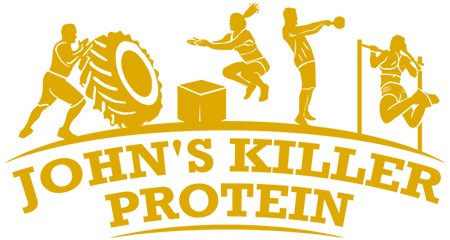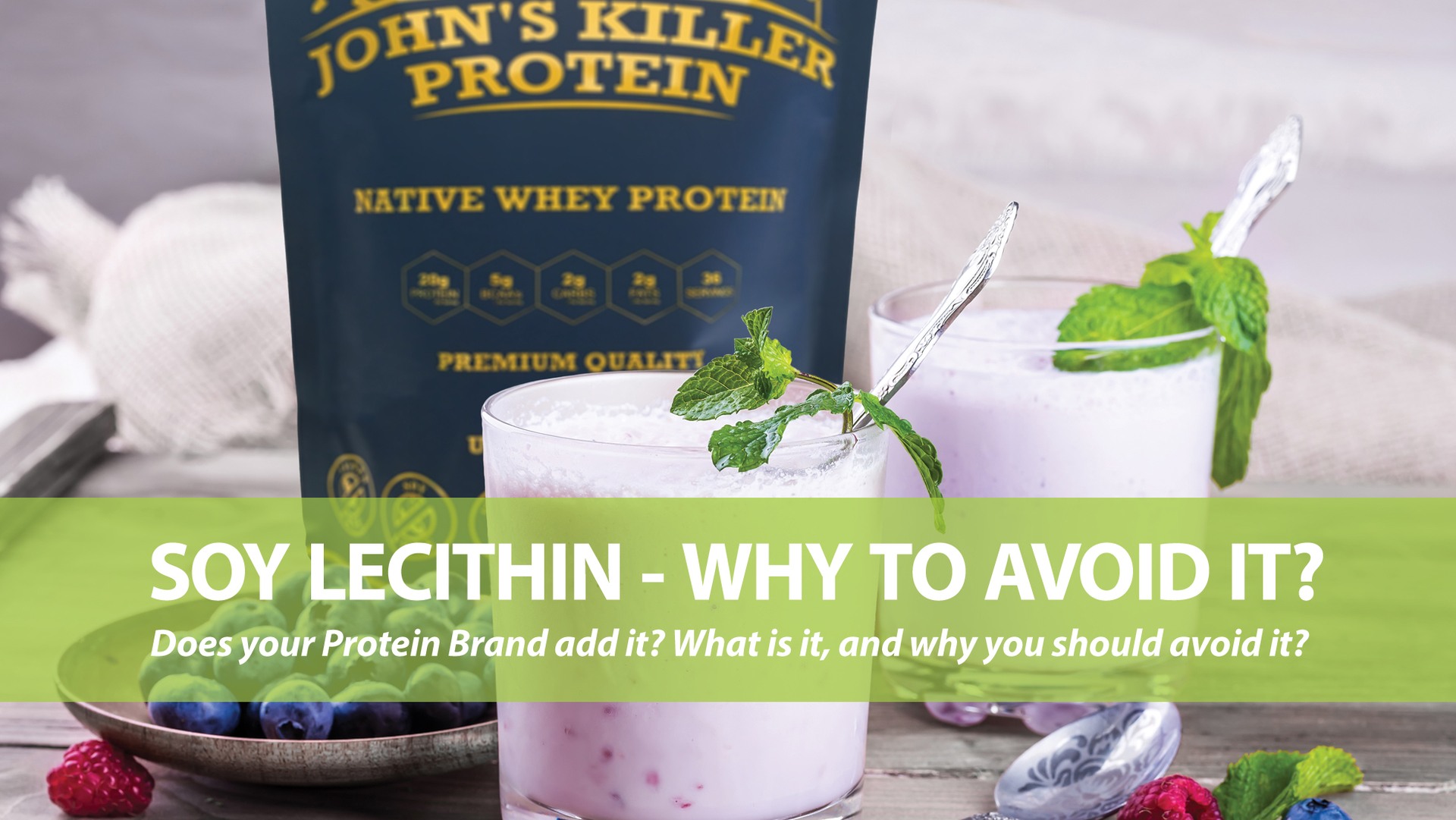What is Soy Lecithin, and why should you avoid proteins that contain this ingredient!
Grab your Protein container and take a look at the ingredients listed on the back. Unless it’s one of our John’s Killer Protein® blends, chances are you’ll see an ingredient called Soy Lecithin listed on there. Some brands even try to get creative and will write something like “Contains less than 2% Soy Lecithin” or “Contains an emulsifier (Lecithin from Soy)”; Crafty ways to list Soy Lecithin as an ingredient while trying to minimize its presence in the Protein they are selling you. Unfortunately, Soy Lecithin is found in most of the protein brands sold in the US, and all of the cheaper/lower quality protein supplements sold at big box retail stores. As a matter of fact, when we looked at a random sample of 25 protein brands, 24 of them list Soy Lecithin as an ingredient, with one brand vaguely listing it as an Allergen using the words “Contains Soy”.
But what exactly is Soy Lecithin and why is it in your protein powder? More importantly, why should you avoid protein brands that contain this ingredient? We will answer these questions and discuss why we don’t allow Soy Lecithin (or any Soy byproducts) in any of our protein blends. Most importantly, we will explain why we believe you should avoid protein brands that contain Soy Lecithin.
Brief history of Soy Lecithin
Soy Lecithin first appeared in the United States in 1929. The first Patent to produce Soy Lecithin in the US was issued on December 27, 1932 to Albert Schweiger (Patent No. 1,892,588) for producing a light-colored lecithin by bleaching it with hydrogen peroxide, a process that is still used today.
Soy Lecithin is a gummy sludge-like substance left over after crude Soy oil goes through a degumming process. It has a dark reddish-brown color, and a consistency ranging from a thick jell-like substance to a plastic solid. To make this byproduct more marketable, manufacturers further process it with Hexane or Ethanol-Benzol. The Hexane/Ethanol-Benzol process gives Soy Lecithin its creamy white color, reduces its odor, and gives it a less bitter flavor. This makes Soy Lecithin easier to use (and conceal) by manufacturers of cheap, lower grade protein supplements.
Soy lecithin is produced from the Soybean, a crop that is the SECOND most Genetically Modified crop in the world! (The first being Corn). Here’s why 19 countries in Europe completely banned all genetically modified crops from their food supply. We will write more about avoiding GMO ingredients in your Protein Supplements and the importance of choosing a Certified Non-GMO Protein Blend in our next post! An article published by The Weston A. Price Foundation titled “Soy Lecithin: From Sludge To Profit“ provides further insights on the history and dangers of Soy Lecithin use in the US.
Why is Soy Lecithin found in most of the Protein sold in the United States?
So now that you know what Soy Lecithin is and how it’s made, let’s go over why most protein brands sold in the US list it as an ingredient. Soy Lecithin has two main uses:
- It acts as a preservative, delaying product spoilage and extending shelf life in the marketplace.
- It’s used as an emulsifier (blending agent) to allow artificial flavorings, sweeteners, and other additives typically found in flavored and sweetened protein brands to mix well together and keep from separating.
Soybeans are one of the cheapest crops to grow in the US, thanks to large federal subsidies to farmers who choose to grow Soybeans. Soy Lecithin is therefore one of the cheapest lecithins to manufacture. In other words, Soy Lecithin is the cheapest filler, preservative, and emulsifier available in the US.
Almost all of the large corporate protein brands, and many of the smaller makers of cheap/lower-grade protein powders use Soy Lecithin. These companies that use multiple additives, flavors, chemicals or other ingredients to spike, sweeten or flavor their protein blends will almost always need to include Soy Lecithin to get all these different additives to blend and stick together. This is the case because not all of these fillers/additives are water soluble.
Sadly this has become common practice in the US to cheaply manufacture, flavor and sell protein blends to the masses.
Why should you avoid Proteins that contain Soy Lecithin?
Studies show multiple negative effects of consuming (even small amounts of) Soy Lecithin. A simple Google search on the health effects of Soy Lecithin will give you links to countless published articles and studies about the dangers of Soy and Soy Lecithin. This is because Soy Lecithin is produced almost always from Genetically Modified Soybeans, extracted with Hexane and/or Ethanol-Benzol, and often times further bleached with Hydrogen Peroxide. Also, in the US, during growing, harvesting and processing genetically modifying Soybeans, crops are exposed to pesticides proven to have negative effects on human health. Studies, dating back to 1981, show these pesticides survive manufacturing and processing of Soybeans, end up in the actual Soy Lecithin byproduct, and ultimately in the Protein Supplements that contain them.
A study published in Food And Chemical Toxicology found that Soy Lecithin is a strong estrogenic, shown to disrupt thyroid and endocrine hormone production, dramatically increasing estrogen levels. Not exactly what you look for in a protein brand intended to help you increase lean muscle mass, recover and grow.
The top 3 reasons to avoid protein brands that contain Soy Lecithin are:
- Phytoestrogens: Soy Lecithin is naturally higher in these Estrogens than any other plant source. This can lead to breast cancer, infertility, decreased sexual libido and uterine fibroids.
- Goitrogen: Soy has been shown to suppress healthy thyroid functions affecting how your metabolism is regulated. An Isoflavone called Genistein, a Phytoestrogen found in soy, blocks your thyroid’s natural production of hormones and its ability to absorb nutrients. A damaged thyroid may cause weight gain, fatigue, disruption of your menstruation and loss of cognitive function.
- Phytic Acid: Soy Lecithin found in Protein Supplements sold in the United States is high in Phytic Acid. Phytic Acid is an Anti-Nutrient and blocks your digestive system’s ability to absorb nutrients (main reason why many studies link Soy to malnutrition).
Other adverse side effects from the use of protein brands that contain Soy Lecithin are:
- Diarrhea
- Nausea
- Headache
- Abdominal Pain
- Bad Breath
- Excessive Weight Gain
- Blurred Vision
- Excessive Perspiration
- Excessive consumption may lead to cerebral abnormalities and poor mental reflexes
- Adverse effects to muscle growth from elevated Estrogen levels
The above side effects have always been wrongly linked to just whey protein powders. Over the years, consumers have just chalked up these side effects to whey protein concentrates and whey isolates. However, research consistently show that it’s not the whey protein that causes these side effects, it is in fact the Soy Lecithin (along with other artificial filler and additives) commonly added to whey protein sold in the US that cause these adverse reactions.
An article published in the Huffington Post by Dr. Joseph Mercola titled “The Health Dangers Of Soy” gives additional insights into the dangers of Soy Lecithin found in protein brands sold and consumed in the US.
But Soy is healthy…it’s a staple in a lot of Asian cuisines, isn’t it?
It is important to note that Soy Lecithin found in protein brands sold in the United States is very different from Soy consumed in Asian Countries. In the US, Soy Lecithin is extracted from Soy that is NOT fermented and the overwhelming majority (around 99.6%) comes from Genetically Modified Soybeans. The fermentation process of Soybeans and using a Non-Genetically Modified crop (as is often done in Asian Countries and throughout the European Union) breaks down and removes the many harmful effects associated with Soybeans. Sadly, this is not yet a common practice within the Supplements Industry in the US.
I read online that Soy Lecithin is Safe…what gives?
Almost every article written about Soy Lecithin with a claim that Soy Lecithin is harmless will make a statement that it’s harmful only when consumed in large quantities. These articles never define what small vs. large quantities are, or what is or isn’t considered a healthy threshold when consuming Soy Lecithin. Are two protein shakes a day too many? Are two scoops in a single shake still considered safe? What about a single protein shake consumed daily? The truth is if an ingredient is harmful in any quantity, it should be considered downright harmful, period! Especially so if an ingredient like Soy Lecithin is used primarily as a cheap filler, preservative and emulsifier with no added health benefits.
The John’s Killer Protein® difference
At John’s Killer Protein, we believe that protein blends should be created as pure and clean as possible. When ingredients are added, they should be added for a clear and purposeful health benefit. Never as fillers, masking agents, preservatives or emulsifiers. Learn more about what makes John’s Killer Protein® truly unique – click Here.
We believe that protein blends containing Soy Lecithin are not the best thing when trying to enhance the benefits of taking a protein supplement in the first place! We do not allow ingredients extracted with toxic chemicals or derived from genetically modified crops. We don’t believe in using heavily processed ingredients, fillers, artificial additives or any artificial sweeteners. We never use Soy Lecithin and never allow Soy by-products in our protein blends. We ensure there is absolutely zero contamination from Soy beans and Soy Lecithin in our warehouse, and in our blending and packaging equipment. We believe in complete transparency and product integrity and are proud to make what we consider to be the purest, cleanest protein around. Learn more about our commitment to product integrity Here.
Our protein blends will always be Certified GMO Free, Additives Free and Certified Soy Free. We use real organic foods in our protein blends that do not require Soy emulsifying agents. We know our protein blends are perfect just the way nature intended; 100% natural with zero artificial additives or sweeteners. We source the best, real, and certified organic ingredients, and are proud to offer healthy foods packed with the highest quality protein and amino acid profiles.
Final thoughts
If your protein brand contains Soy Lecithin, ask yourself if you’re getting all the benefits you’re expecting from your protein blend; ask yourself if you’re getting that “edge” you’re being promised. Reach out to that brand and ask them why they include Soy Lecithin as an ingredient. If you don’t get a satisfactory answer, It may be time to make a switch to a cleaner, healthier protein blend – a switch to John’s Killer Protein®.
To your health,



I’d recommend you and anyone researching about soy to join the Soy Allergy Board on FB. 5k members affected by refined soy
“The truth is if an ingredient is harmful in any quantity, it should be considered downright harmful, period!”
Vitamin A and D are harmful if you take too much. So they “should be considered downright harmful, period”??
Please use science to back up such a statement.